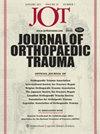Frailty is More Predictive of Mortality than Age in Patients with Hip Fractures
IF 1.6
3区 医学
Q3 ORTHOPEDICS
引用次数: 0
Abstract
To investigate the association between the Comprehensive Geriatric Assessment-based Frailty Index (FI) and adverse outcomes in older adult patients undergoing hip fracture surgery. Retrospective cohort study Academic Level 1 Trauma Center. All patients aged 65 or older who underwent surgical repair of a hip fracture between May 2018 and August 2020 were identified through institutional database review. Outcome Measures and Comparisons: Data including demographics, FI, injury presentation, and hospital course were collected. Patients were grouped by FI as non-frail (FI < 0.21), frail (0.21≤FI<0.45), and severely frail (FI >0.45). Adverse outcomes of these groups were compared using Kaplan Meier survival analysis. Risk factors for one-year re-hospitalization and two-year mortality were evaluated using Cox hazard regression. 316 patients were included, with 62 non-frail, 185 frail, and 69 severely frail patients. The total population was on average 83.8 years old, predominantly white (88.0%), and majority female (69.9%) with an average FI of 0.33 (SD: 0.14). The non-frail cohort was on average 78.8 years old, 93.6% white, and 80.7% female; the frail cohort was on average 84.5 years old, 92.4% white, and 71.9% female, and the severely frail cohort was on average 86.4 years old, 71.0% white, and 55.1% female. Rate of one-year readmission increased with frailty level, with a rate of 38% in non-frail patients, 55.6% in frail patients, and 74.2% in severely frail patients (p=0.001). The same pattern was seen in two-year mortality rates, with a rate of 2.8% in non-frail patients, 36.7% in frail patients, and 77.5% in severely frail patients (p<0.0001). Being classified as frail or severely frail exhibited greater association with mortality within 2 years than age, with hazard ratio of 17.81 for frail patients and 56.81 for severely frail patients compared to 1.19 per 5 years of age. Increased frailty as measured by the Frailty Index is significantly associated with increased two-year mortality and one-year hospital readmission rates following hip fracture surgery. Degree of frailty predicts mortality more strongly than age alone. Assessing frailty with the Frailty Index can identify higher-risk surgical candidates, facilitate clinical decision-making, and guide discussions about goals of care with family members, surgeons, and geriatricians. Prognostic Level III. See Instructions for Authors for a complete description of levels of evidence.虚弱比年龄更能预测髋部骨折患者的死亡率
研究基于老年综合评估的虚弱指数(FI)与接受髋部骨折手术的老年患者不良预后之间的关系。 回顾性队列研究 学术一级创伤中心。 通过机构数据库审查,确定所有在 2018 年 5 月至 2020 年 8 月期间接受髋部骨折手术修复的 65 岁或以上患者。 结果测量和比较:收集的数据包括人口统计学、FI、受伤表现和住院过程。根据 FI 将患者分为非虚弱组(FI < 0.21)和虚弱组(0.21≤FI0.45)。采用卡普兰-梅耶尔生存分析法比较这两组患者的不良预后。采用 Cox 危险回归法评估了一年内再次住院和两年内死亡率的危险因素。 研究共纳入了 316 名患者,其中包括 62 名非体弱患者、185 名体弱患者和 69 名严重体弱患者。总人口的平均年龄为 83.8 岁,以白人为主(88.0%),女性占多数(69.9%),平均 FI 为 0.33(标清:0.14)。非虚弱人群的平均年龄为 78.8 岁,白人占 93.6%,女性占 80.7%;虚弱人群的平均年龄为 84.5 岁,白人占 92.4%,女性占 71.9%;严重虚弱人群的平均年龄为 86.4 岁,白人占 71.0%,女性占 55.1%。一年再入院率随虚弱程度的增加而增加,非虚弱患者为 38%,虚弱患者为 55.6%,严重虚弱患者为 74.2%(P=0.001)。两年死亡率也呈现出同样的模式,非体弱患者的死亡率为 2.8%,体弱患者为 36.7%,而严重体弱患者为 77.5%(P<0.0001)。与年龄相比,被归类为虚弱或严重虚弱与两年内死亡率的关系更大,虚弱患者的危险比为 17.81,严重虚弱患者的危险比为 56.81,而每 5 岁患者的危险比为 1.19。 以虚弱指数衡量的虚弱程度的增加与髋部骨折术后两年死亡率和一年再入院率的增加有显著关联。虚弱程度比单纯的年龄更能预测死亡率。用虚弱指数评估虚弱程度可以确定风险较高的手术候选者,促进临床决策,并指导与家庭成员、外科医生和老年病学家讨论护理目标。 预后等级 III。有关证据等级的完整描述,请参阅 "作者须知"。
本文章由计算机程序翻译,如有差异,请以英文原文为准。
求助全文
约1分钟内获得全文
求助全文
来源期刊

Journal of Orthopaedic Trauma
医学-运动科学
CiteScore
3.90
自引率
8.70%
发文量
396
审稿时长
3-8 weeks
期刊介绍:
Journal of Orthopaedic Trauma is devoted exclusively to the diagnosis and management of hard and soft tissue trauma, including injuries to bone, muscle, ligament, and tendons, as well as spinal cord injuries. Under the guidance of a distinguished international board of editors, the journal provides the most current information on diagnostic techniques, new and improved surgical instruments and procedures, surgical implants and prosthetic devices, bioplastics and biometals; and physical therapy and rehabilitation.
 求助内容:
求助内容: 应助结果提醒方式:
应助结果提醒方式:


